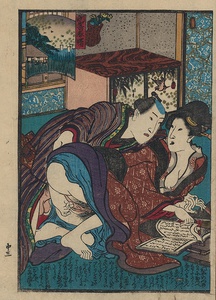| Method | Woodblock (nishiki-e) |
| Artist | Utagawa Kunimori II (1827-1899) |
| Published | 1861 |
| Dimensions | Hanshibon sheet [~222 x 155 cm] |
| Notes |
Series: Twenty eight Famous Views of the East Author: Joko Sanjin possible pseudonym of Shotei Kinsui Print six from Volume II of Kunimori's Twenty eight Famous Views of the East depicting couples in comparison with views of Edo. In this print a couple lies on the floor, the woman whose kimono is loose leaving her exposed is looking at a shunga album, while the man behind her is pleasuring her with his finger, behind a chest decorated with bamboo and sparrow. In the upper right a koma-e (inset picture). Deluxe printing including metallic pigments. Shunga is the term used for the body of erotic imagery produced in Japan from 1600 to 1900. The term shunga means spring pictures, a euphemism for sex, and is one of several names for erotic material produced in Japan. Shunga took different formats: painted hand scrolls, painted books, printed books and albums, and sets of prints which were sometimes sold in wrappers. As prints they are one of the genres of ukiyo-e, or Floating World prints, which also include fukeiga (landscape prints), and bijin-ga (prints of beautiful women). Most of the major ukiyo-e artists produced shunga material at some point during their careers, including Utamaro (who produced more erotic books than non-erotic books), Hokusai, and Hiroshige. Produced at the same time as the introduction of full colour woodblock printing, shunga prints and books were made using the most lavish and complicated printing techniques, including gauffrage, metallic inks, mica, complicated printed patterns, and multicolour printing using a high number of different colours. Although prolific in its number and variety, shunga should be seen as more representative of the ideals of the ukiyo, with its emphasis on mutual pleasure, rather than as an accurate representation of Japanese attitudes and practices of sexuality. Shunga present an invitation to pleasure through the bliss of lovemaking and though largely heteronormative, they portray the full gamut of couplings, married or otherwise, often surrounded by lavish settings and objects of pleasure. Utagawa Kunimori II (1827-1899) was an Edo print maker and a pupil of Utagawa Kunisada. Shotei Kinsui (1795-1862) was an Edo author. Reference:International Research Centre for Japanese Studies, Ehon (Uliyo-e Shunga) Database, KC/172/Sh 005128103. Ex. Col.: Peter Darach |
| Framing | mounted |
| Price | £180.00 |
| Stock ID | 53210 |

